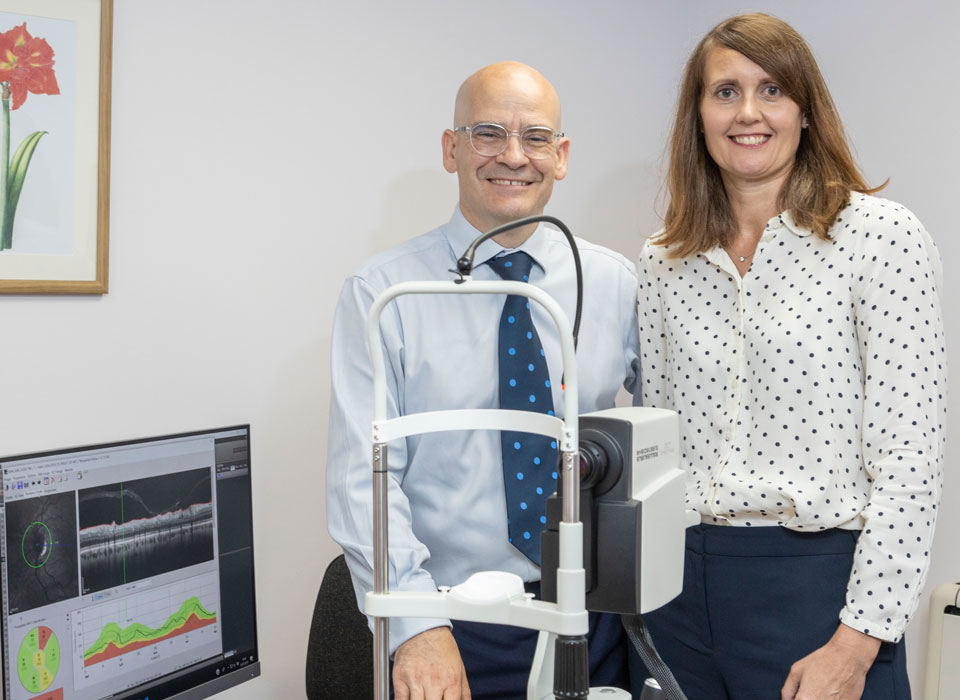- OT
- Industry
- Equipment and suppliers
- “It has improved patient care enormously”
Advertorial
“It has improved patient care enormously”
OT speaks to optometrists and practice owners of Glass & Glass, Douglas and Natalie Glass, about why they love Heidelberg Engineering’s Spectralis OCT


Advertorial content is paid for and produced by a sponsor, and is reviewed and edited by the OT team before publication.
13 September 2019
Why did you choose the Spectralis?
Douglas Glass (DG): We looked at all of the major manufacturers at Optrafair. We felt that it was a straightforward decision considering footprint, ability to upgrade in the future and thus keeping the equipment future proof, and the fact that the system is already in the majority of UK hospitals. It also helped that the Spectralis is used by NASA on the International Space Station. It’s obviously internationally and nationally very well regarded.
Your local hospital uses the Spectralis. How important was this when choosing an OCT and did you speak to any consultants before purchasing?
Natalie Glass (NG): It was a very important factor in deciding which device to purchase. We wanted a system that would eventually allow seamless referral capability. Additionally, the local ophthalmologist who we met, which was arranged by Heidelberg, gushed about the system and said that he couldn’t live without it.

What do you think the best features of the Spectralis are?
DG: Eye tracking and accuracy. The reliability of the image capture is amazing. To know that when you are performing a follow up – weeks, months or years later – you are scanning the exact same area of the retina to within one micron is amazing.
How has it improved patient care in your practice?
NG: It has improved patient care enormously. While we have had leading edge fundus viewing systems for over a decade, this new view of the retina is diagnostically impressive. Our patients are wowed by the image quality and what they can learn about their eyes. From this angle, it has been incredibly helpful in aiding explanations of what we are finding and is happening.
Our patients are wowed by the image quality and what they can learn about their eyes
How do you market and discuss optical coherence tomography (OCT) with patients?
NG: By talking to our patients. We can easily spend 15 minutes talking to relevant patients about why the extra information we will gain is key, why it is vitally important and helpful in disc or macula analysis, for example. We consistently keep our patients updated with new developments via social media, blogs, our website and also in our reminder mailings. The marketing has been on a broad front. Heidelberg’s marketing brochures and leaflets are very well polished and easy to understand.
How much do you charge?
DG: We charge £40, but for the majority of our patients it’s included in their monthly EyeCare plan so that they can access this whenever it is needed.
How do you educate yourselves on interpreting the images?
NG: The Optix OCT forum is extremely helpful. We have also allowed time for OCT peer review during the monthly professional meetings that we hold in practice. The Heidelberg business lounge is an amazing resource and we have also invested in some additional titles to our library.
What has the support from Heidelberg Engineering been like?
DG: Fantastic. In our opinion, second to none. They actively arrange training sessions for us. I think we have had five so far. This has made us much more proficient at using the equipment and interpreting the results. These sessions have been in-house, while we have also attended roadshows and been to the Heidelberg training facility. The entire team is enthusiastic and keen for us to get the very best out of the equipment.

